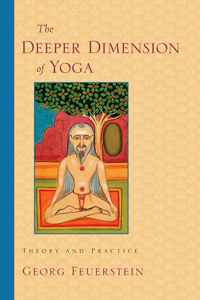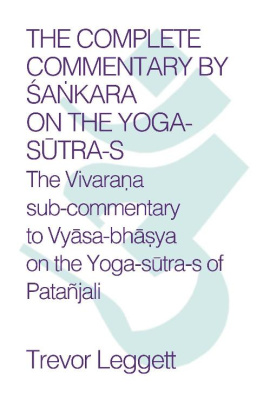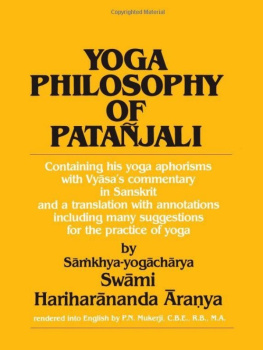Extraordinarily clear.... Hartranft makes Patajalis complications seem somehow obvious.
Shambhala Sun
A Yoga Sutra for the twenty-first century... translated into plain (but not boring) accessible language.... If theres a more succinct explanation of the enduring value of Patajalis work, I'd sure like to hear it.
Yoga Journal
Chip Hartranft has given us a fresh, authoritative, and brilliant new translation of and commentary on the Yoga-Sutra, and an entire generation of American yogis should be deeply grateful. His work successfully combines intellectual precision with emotional accessibilitya powerful marriage seldom even attempted with this notoriously difficult text. Hartranft is careful always to leave Patajalis own genius in the foreground, and as a result the astounding intellectual architecture of the Yoga-Sutra shines through. Bravo!
Stephen Cope, author of Yoga and the Quest for the True Self
Much of contemporary yoga in the West has emphasized breathing and the body. These invaluable practices have been separated from the comprehensive ethical and meditative approach of the great teacher Patajali. Recently there has been an increased interest in correcting this limitation. Chip Hartranfts brilliant new translation of and commentary on Patajalis masterpiece moves interested yogis decisively in this direction. It is a clear and inspiring work of immense value for all serious practitioners.
Larry Rosenberg, author of Breath by Breath and Living in the Light of Death
ABOUT THE BOOK
In just 196 short aphorisms, this classic work of Indian philosophy spells out succinctly how the mind works, and how it is possible to use the mind to attain liberation. Compiled in the second or third century CE, the Yoga-Sutra is a road map of human consciousnessand a particularly helpful guide to the mind states one encounters in meditation, yoga, and other spiritual practices. It expresses the truths of the human condition with great eloquence: how we know what we know, why we suffer, and how we can discover the way out of suffering. Chip Hartranfts fresh translation and extensive, lucid commentary bring the text beautifully to life. He also provides useful auxiliary materials, including an afterword on the legacy of the Yoga-Sutra and its relevance for us today.
CHIP HARTRANFTS work bridges the traditions of yoga and Buddhist meditation. He is the founding director of The Arlington Center, dedicated to the integration of yoga and dharma practice, and has taught a blend of movement and stillness to students in the Boston area since 1978. A student of yoga chiefly in the Krishnamacharya traditions, Chip has also practiced vipassana meditation for many years. He leads annual retreats in the United States and abroad, blending yoga movement, breathwork, and mindfulness.
More information, including how to contact Chip Hartranft and The Arlington Center, can be found at www.arlingtoncenter.org.
Sign up to learn more about our books and receive special offers from Shambhala Publications.

Or visit us online to sign up at shambhala.com/eshambhala.

A New Translation with Commentary

CHIP HARTRANFT

SHAMBHALA
Boston & London
2011
Shambhala Publications, Inc.
Horticultural Hall
300Massachusetts Avenue
Boston, Massachusetts02115
www.shambhala.com
2003by Chip Hartranft
Cover art: Painting by Peter DiGesu, Western Slope.
All rights reserved. No part of this book may be reproduced in any form or by any means, electronic or mechanical, including photocopying, recording, or by any information storage and retrieval system, without permission in writing from the publisher.
Library of Congress Cataloging-in-Publication DataPatajali.
[Yogasutra. English & Sanskrit]
The Yoga-Sutra of Patajali: a new translation with commentary/Chip Hartranft.
p. cm.
Includes bibliographical references.
eISBN 978-0-8348-2580-2
ISBN978-1-59030-023-7
1.YogaEarly works to1800. I. Hartranft, Chip. II. Title. III. Series.
B132.Y6P24313 2003
181.452dc21
2002026877
To Patajali and Siddhartha Gautama,
spiritual physicians to humanity,
and to Didi, who is mine
CONTENTS
PUBLISHERS NOTE
This book contains many Sanskrit diacritics and special characters. If you encounter difficulty displaying these characters, please set your e-reader device to publisher defaults (if available) or to an alternate font.
The Yoga-Stra of Patajali is one of the most enlightening spiritual documents of all time. Nearly two thousand years old, this collection of 196 compact observations on the nature of consciousness and liberation remains unrivaled for its penetrating insight. Though brief, the Yoga-Stra manages to cut to the heart of the human dilemma. With uncommon directness, Patajali analyzes how we know what we know and why we suffer. He then provides a meditative program through which each of us can fulfill the primary purposes of consciousness: to see things as they are and to achieve freedom from suffering. Weaving the threads of ancient yogic knowledge into a detailed map of human possibility, the Yoga-Stra stands as a testament to heroic self-awareness, defining yoga for all time.
Even today, from a distance of two millennia, we can be sure that Patajalis inward quest arose from a deeply ingrained desire to extract happiness and meaning from the mysteries of life, consciousness, and mortality. Such a desire has been universal among humans of all cultures since prehistory, and it resonates in us as strongly today as ever. In fact, yoga now enjoys an unprecedented and ever growing popularity in East and West. Just as Western thought and technology have crossed geographical borders and found a home in India, Indian thought long ago migrated throughout Southeast Asia, China, and Japan, profoundly enriching the cultures of each region, and has continued to spread across the globe. Today the central themes of Indian thought, especially regarding consciousness, continue to penetrate both Asian and Western worlds of art, philosophy, and spirituality, providing a much-needed counterbalance to Western orthodoxies. These patterns of cross-fertilization reflect a universality that labels like Indian and Western obscure.
However, most of the yoga practiced worldwide today would be unrecognizable to earlier yogis like Patajali who attained realization in meditative stillness. Had he lived some seven centuries later, in the tenth century instead of the third, his system might well have incorporated movements from the leading form of yoga now practiced, hatha yoga, which was developed in part to temper the bodymind and focus its energies for meditation. In Patajalis era, though, the yoga posture, or sana, was simply a means of sitting as steadily and effortlessly as possible and was not an exercise system of any kind. This older, contemplative yoga has come to be known as
Next page











